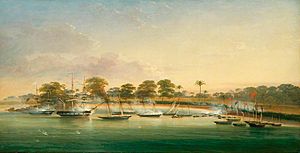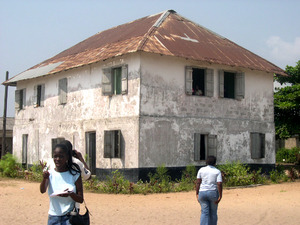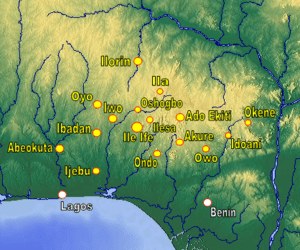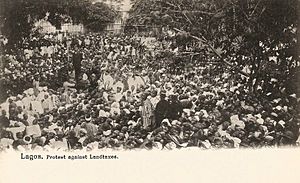Lagos Colony facts for kids
Quick facts for kids
Lagos Colony and Protectorate
|
|||||||||
|---|---|---|---|---|---|---|---|---|---|
| 1862–1906 | |||||||||
 |
|||||||||
| Capital | Lagos | ||||||||
| Official languages | English | ||||||||
| Government | British Colony | ||||||||
| History | |||||||||
|
• Established
|
5 March 1862 | ||||||||
|
• Disestablished
|
28 February 1906 | ||||||||
|
|||||||||
| Today part of | Nigeria | ||||||||
The Lagos Colony was a British area of land in what is now southern Nigeria. It was centered around the important port city of Lagos. On August 6, 1861, Britain took control of Lagos. This happened after Commander Beddingfield of HMS Prometheus, along with the British Consul, William McCoskry, used threats of force.
The local ruler, Oba Dosunmu of Lagos, tried to resist for 11 days. But he eventually gave in and signed a treaty, giving Lagos to the British. Lagos was officially declared a British colony on March 5, 1862. By 1872, Lagos was a busy trading hub with over 60,000 people.
Later, between 1890 and 1897, the colony expanded its control over most of Yorubaland. This area was experiencing long wars between its states. In February 1906, the Lagos Colony became part of the new Southern Nigeria Protectorate. Then, in January 1914, Lagos became the capital of the larger Protectorate of Nigeria. Today, Lagos is the largest city in West Africa. In 2011, its population was estimated to be over 9 million people.
Contents
Where Was Lagos Colony Located?
Lagos started as a small fishing village on Lagos Island. This island is located in Lagos Lagoon, which is a large, safe harbor on the Atlantic coast of Africa. It's found in the Gulf of Guinea, west of the Niger River delta. Long sand strips protect the lagoon from the open ocean. These strips stretch for about 100 kilometers (60 miles) in both directions.
Lagos has a tropical savanna climate, meaning it has two rainy seasons. The heaviest rains fall from April to July. A lighter rainy season occurs in October and November. The total rainfall each year is about 1900 millimeters (75 inches). Average temperatures range from 25 °C (77 °F) in July to 29 °C (84 °F) in March.
For many years, the main products from the region were palm oil and palm kernels. Making palm oil was mostly a job for women. Later, other goods were exported, including copra (from coconuts), guinea grains, gum copal, camwood, and sesame (benne).
How Did Lagos Begin?

The very first version of Lagos was a fishing community of the Awori Yoruba people. They lived on the islands and peninsulas that make up the modern state. The families living there believed their ancestors came from a person named Olofin. Today, the descendants of Olofin are known as the Idejo or "white cap chiefs" of Lagos.
In the 16th century, soldiers from the Oba of Benin attacked and took over Lagos Island. This happened during the Benin kingdom's expansion. They set up a war camp in the town, and it became known as Eko. By the 17th century, Eko became an important port city within the Benin Empire. The kings of Lagos since then have claimed to be descendants of a warrior named Ashipa. Some say Ashipa was a prince of Benin, while others say he was an Awori adventurer loyal to the Benin king. The Idejo chiefs, however, remained Yoruba. Ashipa's son built his palace on Lagos Island. His grandson later moved the government's main office from the Iddo peninsula to this palace. In 1730, the Oba of Lagos invited Portuguese slave traders to the island. Soon, a busy slave trade developed there. In the 18th century, Lagos was still technically a small state under the Benin Empire. However, it was becoming more independent and powerful as Benin's influence decreased.
In the early 1800s, the Yoruba mainland was often at war. This was due to internal conflicts and attacks from neighboring states to the north and west. By this time, the fortified island of Lagos had become a major center for the slave trade. The United Kingdom had stopped importing slaves to its colonies in 1807. It then abolished slavery in all British territories in 1833. The British became very active in trying to stop the slave trade.
At the end of 1851, a British naval force attacked Lagos. They forced the city to surrender. They removed Oba Kosoko from power and put Oba Akitoye in his place. Akitoye was more willing to cooperate with the British. On January 1, 1852, they signed a treaty that made slavery illegal in Lagos. A few months later, Louis Fraser was sent to the island as a vice-Consul. The next year, Lagos became a full consulate, with Benjamin Campbell as the Consul.
A Yoruba church leader named James White wrote in 1853: "By taking Lagos, England has done something that the grateful children of Africa will remember for a long time... One of the main causes of the slave trade has been removed."
Tensions between the new ruler, Akitoye, and supporters of the old ruler, Kosoko, led to fighting in August 1853. Kosoko tried to take the town back but failed. However, Akitoye died suddenly on September 2, 1853. After talking with local chiefs, the consul declared Dosunmu, Akitoye's oldest son, the new Oba. Over the next few years, the British consulate in Lagos slowly became a form of protectorate. Lagos became a base from which the British gradually expanded their control over the surrounding areas. This expansion was mainly driven by the needs of trade and security.
The CMS Grammar School was started in Lagos on June 6, 1859. It was founded by the Church Missionary Society. The school was based on the CMS Grammar School in Freetown, Sierra Leone.
Lagos Colony's First Years

In August 1861, a British naval force entered Lagos. They officially took over Lagos as a British colony through the Lagos Treaty of Cession. King Dosunmu's powers were greatly reduced. Consul William McCoskry became the acting governor. As a colony, Lagos was now protected and directly ruled by Britain. Africans born in the colony were considered British subjects. This meant they had full rights, including access to British courts. In contrast, Africans in the later protectorates of southern and northern Nigeria were protected people but remained under the rule of their traditional leaders.
In the early years, trade with the interior was very difficult. This was because of a war between Ibadan and Abeokuta. The Ogun River, which led to Abeokuta, was not safe for canoes. Travelers were at risk from Egba robbers. On November 14, 1862, Governor Henry Stanhope Freeman told all British subjects to leave Abeokuta and return to Lagos. He said the chiefs of Abeokuta would be responsible for any property left behind. In May 1863, Acting Governor William Rice Mulliner met with the Bashorun of Abeokuta. The Bashorun explained that recent robberies were due to a custom of stopping trade to force men to join the war. He said the stealing would stop when the war ended. In the meantime, traders should not travel to Abeokuta because their safety could not be guaranteed.
Even though the slave trade had been stopped, and slavery was illegal in British territory, it still continued in the region. Lagos was seen as a safe place by runaway slaves. These runaways became a bit of a problem for the government. McCoskry set up a court to hear cases of abuse against slaves and cases of runaway slaves from the interior. He also created a "Liberated African Yard" to give jobs to freed runaways until they could support themselves. He didn't think ending slavery completely in the colony would be practical at that time.
McCoskry and other merchants in the colony did not like the work of missionaries. They felt the missionaries interfered with trade. In 1855, McCoskry was among those who signed a petition to stop two missionaries from returning to Lagos after their leave. McCoskry shared his views with the explorer Richard Francis Burton. Burton visited Lagos and Abeokuta in 1861 and also disagreed with missionary work.
Freeman, the next governor, agreed with Burton. They believed that black people were more likely to become Muslim than Christian.
Freeman tried to stop Robert Campbell from starting a newspaper in the colony. Campbell was a Jamaican man of mixed Scottish and African heritage. Freeman thought a newspaper would be "a dangerous tool in the hands of semi-civilized Negroes." However, the British government disagreed. The first issue of Campbell's newspaper, the Anglo-African, was published on June 6, 1863. Before this, in 1854, there was another newspaper called Iwe Iroyin Yoruba fun awon Egba ati Yoruba. This was truly the first Nigerian newspaper.
How Lagos City Grew
When the colony was founded in 1861, a small legislative council was created. Its main job was to help and advise the Governor, but it didn't have formal power. This council continued until 1922. Most of its members were colonial officials. In 1863, the British introduced the Lagos Town Improvement Ordinance. This law aimed to control how the town and its surrounding areas were built and developed.
The Lagos administration was combined with that of Sierra Leone in 1866. Then, in 1874, it was moved to the Gold Coast. The leaders in Lagos worked hard to get their independence back. This finally happened in 1886.
Colonial Lagos grew into a busy, diverse port city. Its buildings combined Victorian and Brazilian styles. The Brazilian style came from skilled builders and masons who had returned from Brazil. The black elite in Lagos included English-speaking "Saros" from Sierra Leone. It also included freed slaves who had returned from Brazil and Cuba. By 1872, the colony's population was over 60,000 people. Fewer than 100 of these were of European origin. In 1876, goods brought into the colony were worth £476,813, and goods sent out were worth £619,260.
On January 13, 1874, leaders of the Methodist community, including Charles Joseph George, met. They discussed starting a secondary school for Methodists, as an alternative to the CMS Grammar School. After raising money, the Methodist Boys School building opened in June 1877. On February 17, 1881, George was one of the community leaders who helped lay the foundation stone for the Wesley Church. This church was built at Olowogbowo, in the west of Lagos Island.
The colony had largely succeeded in stopping slavery. It had also become a successful trading community. However, before the European "scramble for Africa" began, the British government thought the Lagos colony was somewhat unsuccessful. The British had refused to get involved in the politics of the interior. Also, strong competition among British and French companies along the Niger meant it wasn't making much profit.
Yoruba Wars and British Expansion
In 1877, a trade war started between Ibadan and both Egba Alake (Abeokuta) and Ijebu. Further east, the Ekiti and Ijesa people rebelled against Ibadan rule in 1878. Occasional fighting continued for the next sixteen years. Help from Saro merchants in Lagos, who provided modern rifles, gave the Ekiti an advantage. The Lagos government, which was then under Accra in the Gold Coast, was told to stay out of the conflict. This was despite the harm it was doing to trade. Attempts by Saro merchants and Fulani leaders to help make peace were rejected.
By 1884, George Goldie's United African Company had taken over all its competitors. It also removed French trading posts from the lower Niger River. This situation allowed Britain to claim the entire region at the Berlin Conference the next year. In 1886, Lagos became a separate colony from the Gold Coast. Cornelius Alfred Moloney became its Governor. The new colony's legislative council had four official members and three unofficial members. Governor Moloney chose two Africans as unofficial representatives: the clergyman James Johnson and the trader Charles Joseph George. At this time, European powers were strongly competing for African colonies. Meanwhile, the groups fighting in the Yoruba wars were getting tired. The Lagos government, working through Samuel Johnson and Charles Phillips of the Church Mission Society, arranged a ceasefire. Then they made a treaty that guaranteed the independence of the Ekiti towns. However, Ilorin refused to stop fighting, so the war continued.
The British were worried about the growing influence of the French in nearby Dahomey. So, they set up a post at Ilaro in 1890. On August 13, 1891, a treaty was signed. This placed the kingdom of Ilaro under the protection of the British queen. When Governor Gilbert Thomas Carter arrived in 1891, he followed a strong policy. In 1892, he attacked Ijebu. In 1893, he toured Yorubaland, signing treaties, forcing armies to break up, and clearing the way for a railway from Lagos to Ibadan. So, on February 3, 1893, Carter signed a protection treaty with the Alafin of Oyo. On August 15, 1893, acting Governor George Chardin Denton signed a protectorate agreement with Ibadan. British control was firmly established throughout the region after the attack on Oyo in 1895. It was also strengthened by the capture of Ilorin by the Royal Niger Company in 1897.
Later Years of Lagos Colony
In 1887, Governor Maloney sent a report to the Royal Botanic Gardens, Kew. In it, he described plans for a Botanic Station in Lagos. The goal was to develop local trees and plants that had commercial value. By 1889, rubber had been brought to the colony. It was showing excellent results and quality. A report that year also mentioned other products. These included gum, coconut oil (for which a small crushing business looked promising), various fibers, camwood, borewood, and indigo. These were also seen as having great potential.
The city of Lagos grew largely without a clear plan. Its growth was made difficult by the many swamps, canals, and sand spits. William MacGregor, who was governor from 1898 to 1903, started a campaign against malaria. He drained swamps and tried to destroy the mosquitoes that spread the disease.
Telephone connections with Britain were set up by 1886. Electric street lighting was installed in 1898. In August 1896, Charles Joseph George and George William Neville, both merchants and members of the Legislative Council, asked for the railway station to be built on Lagos Island instead of at Iddo. They also asked for the railway to be extended to Abeokuta. George led this request and explained its many business benefits. A large strike happened in the colony in 1897. This has been called the "first major labor protest" in African history.
On February 21, 1899, the Alake of the Egba signed an agreement. This allowed the building of a railway through their land. The new railway from Aro to Abeokuta was opened by the Governor in December 1901. The Alake was present at the opening.
In 1901, the first qualified African lawyer in the colony, Christopher Sapara Williams, was chosen for the Legislative Council. He served as a member until he died in 1915. In 1903, there was a disagreement about the payment of tolls. These tolls were collected from traders by local rulers, but Europeans were exempt. The alternative was to replace the tolls with a government payment. MacGregor asked for opinions from Williams, Charles Joseph George, and Obadiah Johnson. They were important local leaders. All of them wanted to keep the tolls to avoid upsetting the rulers. In 1903, Governor MacGregor's government prepared a Newspaper Ordinance. It was supposedly designed to stop false information from being published. George, Williams, and Johnson, the three Nigerian council members, all objected. They argued that the law would limit freedom of the press. George said, "any obstacle in the way of publishing newspapers in this colony means sending Lagos back to how it was forty or fifty years ago." Despite these objections, the law was passed.
Walter Egerton was the last Governor of Lagos Colony. He was appointed in 1903. Egerton strongly supported extending the Lagos – Ibadan railway further to Oshogbo. The project was approved in November 1904. Construction began in January 1905, and the line reached Oshogbo in April 1907. The colonial office wanted to combine the Lagos Colony with the protectorate of Southern Nigeria. In August 1904, Egerton was also appointed High Commissioner for the Southern Nigeria Protectorate. He held both positions until February 28, 1906. On that date, the two territories were combined. The new combined area was called the Colony and Protectorate of Southern Nigeria. In 1914, Governor-General Sir Frederick Lugard combined this territory with the Protectorate of Northern Nigeria. This formed the Colony and Protectorate of Nigeria.
Lagos was the capital of Nigeria until 1991. Then, the role was given to the Federal Capital Territory, Abuja. Lagos remains the commercial capital of Nigeria. In 2011, its population was estimated to be over 9 million people.
Governors of Lagos Colony
Here are the Governors who led the Lagos Colony:
| Took office | Left Office | Governor | Notes |
|---|---|---|---|
| 6 August 1861 | 22 January 1862 | William McCoskry | Acting Governor |
| 22 January 1862 | April 1865 | Henry Stanhope Freeman | |
| 1863 | 25 July 1863 | William Rice Mulliner | Acting. Died on July 25, 1863, at age 29. |
| August 1863 | 19 February 1866 | John Hawley Glover | Acting until April 1865. Served as Administrator or colonial secretary until 1872. |
From 1866 to 1886, Lagos was under the control of Sierra Leone, and then the Gold Coast.
| Took office | Left Office | Governor | Notes |
|---|---|---|---|
| 13 January 1886 | 1891 | Cornelius Alfred Moloney | |
| 1889 | 1890 | George Denton | Acting for Moloney |
| 1891 | 1897 | Sir Gilbert Thomas Carter | |
| 1897 | 1899 | Henry Edward McCallum | |
| 1899 | 1903 | Sir William MacGregor | |
| 1903 | 16 February 1906 | Walter Egerton |
See also
- Government Gazette (Lagos)
- Timeline of Lagos









